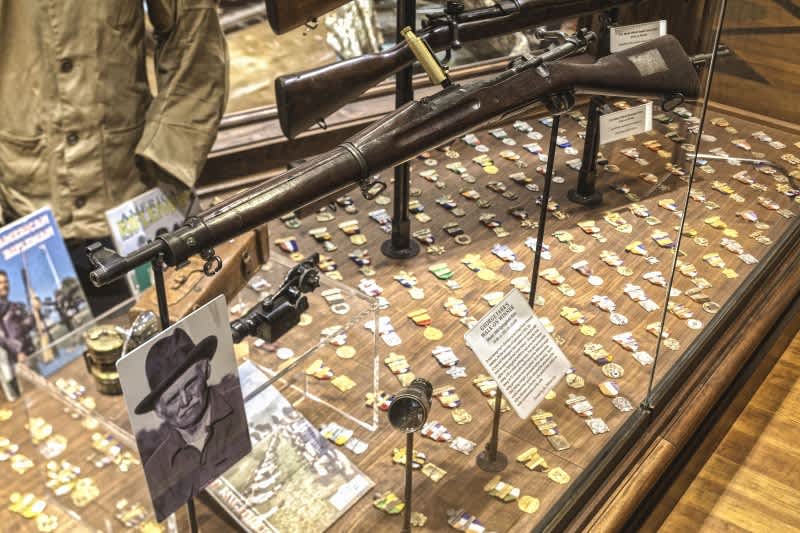Photos: George Farr’s 71-bullseye M1903 Springfield Rifle
K.J. Houtman 11.12.15

In high-level shooting competitions, skilled marksmen often fine-tune their rifles and ammunition for incredible accuracy. But back in 1921, a 63-year-old man attended the Camp Perry National Championships and put on a nearly unheard-of performance. He used a standard-issue M1903 Springfield rifle and stunned spectators and participants alike.
His name was George Farr, but his friends called him Pop.
“It was like an average Joe walking into Yankee Stadium and pitching a no-hitter for the World Series,” said Jim Supica, Director of NRA Museums. The NRA Sporting Arms Museum in Springfield, Missouri displays the exact rifle Farr used at the range that day.
Used in World War One and later in World War Two, the rifle was a sturdy bolt-action workhorse chambered in .30-06 Springfield. The hosts of the National Championship at Camp Perry invited civilians to participate, and good old George Farr walked up and said, “I’ll take that one.” With it, and a random run-of-the-mill box of accompanying cartridges, Farr proceeded to punch 71 consecutive bullseyes at 1,000 yards.
“He would have done more, the legend goes,” said Supica, “but they ran out of daylight. It’s just incredible.” The rifle’s moniker is “71X” accordingly.
There was no scope, just standard iron sights. Everything about this rifle and ammunition fell well within the confines of the term “standard issue.” Military officials often sold used rifles after events like this, and that night as the mist rolled in off Lake Erie and the smoke settled, everyone was thrilled when they offered Farr a chance to purchase the rifle.

“It was placed up for sale for $41,” said Supica. Camp Perry has traditionally sold firearms, still does, in fact. “But Farr didn’t have the money to spend. The field of competitors, beyond ecstatic at the display of excellent marksmanship, pooled their own resources to present the rifle, and a box from the batch of ammo, as gifts.”
One might fast forward and assume Farr won the competition that day. He didn’t. A military-trained long-range team member started earlier in the day and didn’t run out of light. Sergeant John W. Adkins hit 76 bullseyes.
The match was for the Wimbledon Cup, a silver-bowl trophy forged in Great Britain and given, the first time, for the top contender in the shooting matches at Wimbledon in the 1870s. Record keeping of winners began in 1875, with presentation of the Cup occurring annually since. Today, one of the awards at the National Championship is the Farr Trophy in honor of George Farr. Does that mean he was cut of Championship cloth, even though he didn’t win?
“I’m sure he was,” said Sergeant First Class Emil Praslick, Head Coach and Team Chief of the US Army’s Service Rifle Section and a gifted long range shooter himself. “It was an impressive achievement. Not everyone who can shoot well [at] long range can take the pressure of competition to be a champion,” continued Praslick. “It looks like he made that pressure his friend and not his enemy.” True champions capitalize on the circumstances presented and their focus gets harder, according to the sergeant.

Farr’s accomplishment was an incredible shooting feat, even by today’s standards. Current targets at 1,000 yards are 44 inches in diameter; in Farr’s day they were a 36-inch-diameter circle.
“We still do have civilian competitors in long range,” added Praslick, acknowledging there are some who can hold their own. “One of the most successful civilians winning the Farr trophy, multiple times I believe, was Joe Sopko.” Sopko won in 2000 and again in 2006.
“Even with 2015 technology in equipment, 20 consecutive [bullseyes] is unusual,” said Praslick. “We adjust sights with a lot of precision. It was much more difficult back then.” One minute of angle (MOA) equals 10 inches at 1,000 yards. Today’s sights adjust with one-fourth MOA. Farr’s adjustments no doubt involved a lot of holdover and Kentucky windage.

The next time you’re near Springfield, Missouri—or plan a special trip to see the flagship Bass Pro Shops store—check out the M1903 Springfield “71X” rifle at the NRA Sporting Arms Museum, open to the public seven days a week.
K.J. Houtman is the author of the award-winning Fish On Kids Books series, chapter books for eight- to 12-year-olds with adventures based around fishing, camping, and hunting. Her work is available at Amazon and local bookstores. Find out more at fishonkidsbooks.com.

